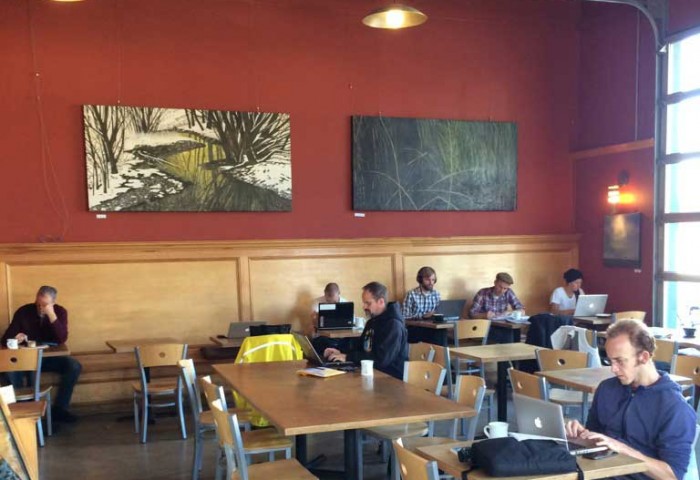As someone who’s been traveling the world and working full time for two years, I’ve stayed in more accommodations than I can count. And before I began my journey as a digital nomad, finding housing that was affordable and community-based was something I was most apprehensive about.
While hostels get the reputation for having a party atmosphere and hotels make it difficult to meet fellow long-term travelers (not to mention the higher nightly cost), I yearned for an in-between. Something for the modern, career-driven digital nomad. And that’s where co-living spaces came in.
I’ve stayed at a number of co-living spaces across Europe, Asia, and South America, and they’re easily my favorite accommodation type. Here’s why they’re so great for digital nomads.
Community-Driven Both Socially and Career-wise
When I began my digital nomad journey, I looked for communities of like minded people online — perusing Reddit, Facebook groups, and Meetups. And while that did help understand the cities best fit for digital nomads, I wasn’t as lucky in finding recurring meetups wherever I went.
Co-living spaces have built in communities of digital nomads. I’ve met some of the smartest, open-minded people who are curious to learn about different cultures, places, and cuisines, while simultaneously furthering their careers.
Oftentimes, hosts of co-living spaces will prepare weekly skillshares, barbeques, yoga classes, and community dinners to bring everyone together. In these spaces, I’ve met entrepreneurs, programmers, professors, marketing managers, and even physicians. Co-living spaces are geared towards the modern, remote professional.
Experience a Diverse Environment
Beyond the community aspect of staying at co-living spaces, you’re surrounded by people of diverse backgrounds. It’s incredible to share the common passion for travel and remote work with those who have very different life experiences.
Being surrounded by people from all walks of life teaches you a lot about cultures beyond the country you’re situated in — learn how to cook Moroccan food in Argentina, or how to drink the popular Argentinian mate in Morocco. Constantly meeting new and different people is my favorite part of staying at co-living spaces.
Guaranteed Fast Internet and Co-working Space
Nothing is worse than being on a spotty video call with a client or your boss.
Every co-living space I’ve stayed at has had a distraction-free space or coworking space with fast and reliable internet. With many fellow residents working for companies or clients in different timezones, it’s important to have an area to keep your regular schedule without any interruptions.
Before you stay at a coworking space, be sure to ask for their internet speed and if there’s a dedicated space to work. It will make all of the difference.
Fully-Stocked Bathroom and Kitchen
One part of constant travel that you want to avoid is repeatedly buying kitchen or bathroom staples. Co-living spaces often offer the kitchen basics like olive oil, salt, pepper, and coffee or tea. And even better, most residents are open to sharing their food with each other.
As for the bathroom, it’s common to have towels, soap, toilet paper, and cleaning supplies readily available.
It might seem simple, but when you’re in a new country or neighborhood, it takes time to learn the norms like where to buy groceries and toiletries. And sometimes you don’t need to buy an entire container for your stay, so having the basics prepared makes you feel comfortable as soon as you walk in the door.
Offered Activities and Events
As I mentioned before, co-living spaces are community-based and geared towards digital nomads who want to explore the area and spend time with one another.
Many co-living spaces will offer paid and free activities to keep you busy before and after work, or on the weekends. For example, I stayed in one co-living space that offered paid surf lessons with an in-house instructor in the mornings. That same space offered morning yoga sessions for free.
Some will also offer weekend excursions to explore as a group like wine tastings, boat rides, or even ski lessons.
How to Find Co-living Spaces (Including My Favorites!)
After much research and word-of-mouth (whether online or from a digital nomad friend), I’ve stayed at many different co-living spaces. But let’s face it: some co-living spaces are better than others.
One platform that’s great for sourcing co-living spaces around the world is Anyplace. The housing marketplace outlines what to expect from a co-living space and all the details about the area — for example, some listings share how many minutes it takes to walk or drive to important places like the grocery store, public transportation, and the beach or mountain trails.
The best part is that you only need to apply for the platform once and then you have access to all of the properties moving forward. That might seem small, but when I stayed at Urban Campus in Madrid for one month, I needed to go through a background check, share my proof of income, share my passport and license photo, and go through a video interview before being accepted to stay there — not something you want to go through every time you book an accommodation.
And now for the three best co-living spaces I’ve stayed at.
Nine Coliving
Situated in the Canary Islands in Tenerife, Spain, Nine Coliving is a remote worker’s dream. The co-living space is in a historic building with multiple private and shared rooms. It’s equipped with a fully-stocked kitchen, co-working space, rooftop, barbeque, and gym. And there are multiple activities every week including yoga, surfing, skillshares, family dinners, and Sunday barbeques.
There’s no doubt that my favorite co-living experience was at Nine Coliving.
Outsite
Outsite is a chain of co-living spaces that cater to digital nomads. I’ve stayed at their Portugal, Bali, and Hawaii locations, and they’re always well-suited for remote workers with co-working areas, high-speed internet, and sometimes even breakfast included. Their properties are on the expensive side, but it can be worth it once and a while for the amenities that they offer.
Since they’re known to attract professionals and remote workers, they’re the perfect place to meet digital nomads.
For example, after meeting a digital nomad at their location in Canguu, Bali, we spent six weeks exploring Argentina together. That wouldn’t have been possible if I didn’t choose to stay in a co-living space.
Urban Campus
Despite the sign on process, Urban Campus is a great place for someone new to Madrid to stay. I stayed at the Mellado location, which is a six-floor apartment building with multiple 3-4 room apartments on each floor. As a resident, you have access to all of the common spaces, a gym, the terrace, and a coworking space. Many of the residents worked at an office in Madrid, however, that meant there was more room in the coworking space for remote workers. They offer community dinners, get-togethers, and all of the residents make plans to get together on their own as well.
Co-living spaces have opened the door to meeting a community of like-minded people while traveling solo. Read reviews, reach out to digital nomads on online forums, and talk to hosts to find out if a property is a fit for your lifestyle.



Responses